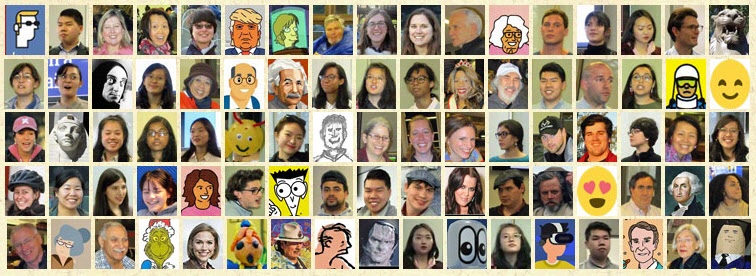
|
Design, Technology , and Engineering benefitting individuals
with disabilities and older adults in the local community |
July 28, 2022 |
|
|
|
|

Perspectives is the newsletter of the
Stanford course,
Perspectives in Assistive Technology.
Latest Summer Update
This newsletter issue further describes course plans for the
coming academic year.
|
Perspectives in Assistive
Technology is a Winter Quarter Stanford course - entering its
seventeenth year - that explores the design, development, and use of
assistive technology that benefits people with disabilities and older adults.
It consists of semi-weekly in-person discussions; lectures by
notable professionals, clinicians, and assistive technology users; field
trips to a local medical center and an accessible inclusive playground; an
Assistive Technology Faire; and student project presentations and
demonstrations. |
Latest Summer
Update
Greetings, members of the Stanford's Assistive
Technology course community,
With this issue, I'll continue to present plans for this
coming academic year's course.

Plans for next academic year's
course
Important dates:
- Monday, September
26th - First day of Fall Quarter classes
- Thursday, December
1st - Winter Quarter course enrollment opens
- Tuesday, January
10th - First class session of Perspectives in Assistive
Technology
Community Attendance - Community members will be
welcome to attend class sessions on campus - masking may be
required.
Guest Lecturers - I have begun contacting past
guest lecturers about their availability as well as considering new presenters.
Six speakers from last academic year have expressed their willingness to
participate once again.
Student Projects - I have received several
student project suggestions, which I will develop into project descriptions for
students to review. |

Request for student project
suggestions - Project suggestions are beginning to be
solicited.
Community members are strongly encouraged to submit
project suggestions for students to pursue. These suggestions must address a
real challenge experienced by an individual with a disability or older adult
who lives in the local community that is not adequately served by existing
commercial products. (Perform an internet search to verify this.) Identify and
describe the challenge rather than imagining a solution. Please do this as soon
as possible so I'll have adequate time to consider all submissions, edit
approved entries, and post them. The deadline is Thursday, December 1st.
If I accept your project suggestion, you will be invited to
"pitch" it to the class on Thursday, January
12th. If a student team selects it, you will have the opportunity to offer
your advice, direction, and expertise in person, by phone, and/or by email. For
more information refer to the Call for Projects
Suggestions and Project
Requirements webpages.
This course
relies on community involvement,
so please suggest a project based upon an
identified problem or challenge. |

Examples of unsuitable project
suggestions - To further aid the project solicitation process, here
are examples of unsuitable project suggestions and explanations of of
why they are not appropriate. Many of these examples are drawn from real
submitted suggestions. It is my hope that the list will guide your project
suggestion thinking.
-
Project Suggestion - I need a new part for my
wheelchair, but the company charges too much money for it. I am sure students
can build a new one less expensively.
Project Suitability Analysis - Copying an
existing part does not exercise students' creative design skills. Fabricating a
ready-to-be-manufactured, lower cost version of an existing product is not a
suitable project goal as a student team's final prototype is a very long way
from a potential commercial product and parts typically represent a fraction of
a product's retail price.
-
Suggestion - I suggest students build me a
wheelchair that is super strong, very lightweight, and
inexpensive.
Analysis - This project suggestion is over
specified as all of the design criteria can not be met and as such is
unachievable. In addition, there is insufficient space on campus to work on
large items such as wheelchairs.
-
Suggestion - My challenge is getting into my
car. I am imagining a seat that rotates out to receive me and then rotates into
position for driving.
Analysis - Car seats that rotate are available
commercially. Students can not work on projects that involve modifying a user's
car or their home.
-
Suggestion - It would be great if I could
wirelessly call for an elevator located in a campus building, instead of having
to press the button.
Analysis - Students are forbidden from working on
projects that modify a campus building or the infrastructure in
general.
-
Suggestion - I care for a family member who is
severely obese. Is anti-gravity close to becoming a reality?
Analysis - Projects' aims and specifications
should be realistic. Project solutions that can only be achieved by employing
magic, violating the laws of physics, defying gravity, creating a perpetual
motion machine, employing materials or technology that do not exist, or
disrupting the space-time continuum are examples of infeasible
projects.
-
Suggestion - My older adult uncle who lives in
Sacramento is challenged by meal preparation tasks.
Analysis - An older adult, a person with a
disability, a family member of a person with a disability, or a health care
professional must be available locally (within 25 miles) to work with the
student project team to further illustrate the problem, offer advice during the
quarter, and test the students' prototypes. Existing products that address meal
preparation tasks are available.
-
Suggestion - I have detailed plans for a new
assistive technology device. I would like a student team to build it for
me.
Analysis - Student teams' projects must not be
physical representation of another's design concept. Fabricating a prototype
from an existing design drawing does not exercise students' creative design
skills.
-
Suggestion - Can students add a new access
feature to my smartphone?
Analysis - Project solutions must not require
access to or modification of proprietary software, such as adding functions to
a cellphone.
-
Suggestion - My older adult mother could
benefit from a device that helps her get into and out of the
bathtub.
Analysis - There are many existing products that
could provide a safe solution. Student project prototypes must not pose any
risk of harm to the user or student team.
-
Suggestion - My assistive technology business
needs an accessible website.
Analysis - Website design, development, or
modification are not suitable project tasks.
-
Suggestion - I have a startup assistive
technology company, but I can't afford to pay engineers to develop my first
product. Can I have a few students work on a project for my company in its lab
space in San Jose?
Analysis - It is not appropriate for students to
be low-cost or free labor for a commercial company. Students must pursue their
projects on campus.
|
Please contact me with your ideas, questions, comments,
and project suggestions - or just to say hello. Please continue to stay safe
& healthy.
Dave Jaffe - Course Instructor
|

To unsubscribe from this newsletter, please email
Dave. |
|






